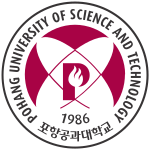포항공과대학교 | |
 | |
| Motto | 성실, 창의, 진취 |
|---|---|
Motto in English | Integrity, Creativity, and Aspiration |
| Type | Private |
| Established | 1986 |
| President | Seong Keun KIM ( ko ) |
Academic staff | 283 (2018) [1] |
| Students | 3,581 (2018) [1] |
| Undergraduates | 1,422 (2018) [1] |
| Postgraduates | 2,159 (2018) [1] |
| Location | , , |
| Campus | Urban |
| Mascot | Postech Ponix (Phoenix) |
| Website | postech |
| | |
- 1 2 3 4 "About POSTECH". POSTECH Official website. POSTECH. Retrieved 12 December 2018.
- ↑ "The Road to Academic Excellence: The Making of World-Class Research Universities". The World Bank September 2011. Retrieved April 17, 2014.
- ↑ Seo, Ji-eun (30 September 2016). "Korea builds advanced particle accelerator". Korea JoongAng Daily . Retrieved 19 May 2020.
- ↑ "QS University Rankings 2025". Top Universities. 2025. Retrieved June 4, 2024.
- ↑ "THE University Rankings 2025 - South Korea". Times Higher Education (THE). 2025. Retrieved October 9, 2024.
- ↑ World University Rankings - 2023 (2024). "South Korea Universities in Top 500 universities". Academic Ranking of World Universities. Retrieved August 15, 2024.
{{cite web}}: CS1 maint: numeric names: authors list (link) - ↑ "QS Asian University Rankings". QS Quacquarelli Symonds Limited. 2024. Retrieved November 8, 2023.
- ↑ "Asia University Rankings 2024". Times Higher Education. 2024. Retrieved April 30, 2024.
- ↑ U.S.News & World Report (2024). "2024-2025 Best Global Universities in Asia" . Retrieved June 24, 2024.
- ↑ "Academic Ranking of World Universities". Institute of Higher Education, Shanghai Jiao Tong University. 2024. Retrieved August 15, 2024.
- ↑ "QS World University Rankings". QS Quacquarelli Symonds Limited. 2025. Retrieved June 4, 2024.
- ↑ "THE World University Rankings". Times Higher Education. 2025. Retrieved October 9, 2024.
- ↑ U.S.News & World Report (2024). "2024-2025 Best Global Universities Rankings" . Retrieved June 24, 2024.
- ↑ "Ahead of the curve: Asia's science and technology institutes mix students and success". Asiaweek May 15, 1998. Retrieved July 6, 2005.
- ↑ "Times Higher Education's World University Rankings 2010-2011". 2015-04-13.
- ↑ "Times Higher Education's 2011-2012 World University Rankings".
- ↑ "QS Asian University Rankings: Overall in 2012". Quacquarelli Symonds. 2012. Retrieved 2012-07-06.
- ↑ "Times Higher Education world top 200 universities".
- ↑ "Times Higher Education's 100 Under 50 Universities 2013". 2015-04-13.
- ↑ Lau, Joyce (2012-06-04). "Who's the Next M.I.T.?". New York Times June 4, 2012. Retrieved April 11, 2014.
- ↑ Yang, Calvin (2013-06-24). "Korean Institute Tops List of Younger Universities". IHT June 25, 2013. Retrieved April 11, 2014.
- ↑ "Introduction". Tae-Joon Park Digital Library. 2005. Archived from the original on February 27, 2014. Retrieved April 17, 2014.
- ↑ "Smart Campus". POSTECH Website. Retrieved October 1, 2013.
- ↑ "POSTECH Spent Most Money on Students". The Chosun Ilbo September 23, 2008. Retrieved September 30, 2013.
- ↑ Seo, Ji-eun (30 September 2016). "Korea builds advanced particle accelerator". Korea JoongAng Daily . Retrieved 31 January 2019.
External links
Wikimedia Commons has media related to Pohang University of Science and Technology .
| China Mainland | |
|---|---|
| Hong Kong | |
| Japan | |
| Korea | |
| Macau | |
| Taiwan | |